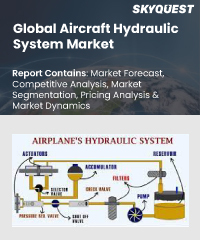
Report ID: SQMIG20A2118

Report ID:
SQMIG20A2118 |
Region:
Global |
Published Date: February, 2024
Pages:
157
|
Tables:
60 |
Figures:
75
North America currently represents the dominant segment in the global aircraft hydraulic system market based on region. The region's dominance can be attributed to the presence of established aerospace manufacturers, a large fleet of commercial and military aircraft, and extensive investments in research and development of advanced aviation technologies. Moreover, North America has a robust aviation infrastructure, including maintenance, repair, and overhaul (MRO) facilities, which drives the demand for aircraft hydraulic systems. Additionally, the region's focus on upgrading existing aircraft fleets with modern hydraulic systems and the procurement of new-generation aircraft with advanced flight control capabilities further solidify North America's leading position in the market.
The fastest-growing segment in the global aircraft hydraulic system market based on the region is Asia Pacific. The region's rapid economic growth, increasing disposable incomes, and expanding air travel demand are fueling the growth of the aviation industry in Asia Pacific. With rising passenger traffic, airlines in the region are actively expanding their fleets, driving the demand for new aircraft equipped with state-of-the-art hydraulic systems. Furthermore, governments in countries like China and India are investing significantly in their defense sectors, leading to the development of indigenous military aircraft and contributing to the growth of hydraulic system adoption in the defense segment. The emergence of low-cost carriers and the establishment of new airlines in the region also add to the increasing demand for aircraft hydraulic systems. As a result, Asia Pacific stands out as the fastest-growing market for aircraft hydraulic systems in the present scenario.
Our industry expert will work with you to provide you with customized data in a short amount of time.
REQUEST FREE CUSTOMIZATIONAircraft Hydraulic System Market size was valued at USD 8.72 billion in 2021 and is poised to grow from USD 9.7 billion in 2022 to USD 22.68 billion by 2030, at a CAGR of 11.2% during the forecast period (2023-2030).
The competitive landscape of the aircraft hydraulic system market is characterized by intense rivalry among key players striving to maintain and expand their market share. Companies in this market are continuously investing in research and development to enhance product performance, reliability, and efficiency. They focus on forming strategic partnerships and collaborations to strengthen their position and expand their geographical presence. Additionally, companies emphasize obtaining certifications and approvals from aviation regulatory authorities to establish credibility and gain a competitive edge. The market also witnesses new entrants attempting to penetrate with innovative solutions, intensifying competition further. Customer-centric approaches, cost-effectiveness, and technological advancements remain critical factors determining success in this highly competitive market. 'Raytheon Technologies Corporation (US)', 'Parker-Hannifin Corporation (US)', 'Safran S.A. (France)', 'Eaton Corporation Plc (Ireland)', 'Liebherr-International Deutschland GmbH (Switzerland)', 'Woodward, Inc. (US)', 'Triumph Group, Inc. (US)', 'Moog Inc. (US)', 'Arkwin Industries Inc. (US)', 'Beaver Aerospace & Defense, Inc. (US)', 'Senior plc (UK)', 'Crane Aerospace & Electronics (US)', 'HYDRO Systems KG (Germany)', 'Sitec Aerospace GmbH (Germany)', 'HYDAC (Germany)', 'Circor International, Inc. (US)', 'The Boeing Company (US)', 'United Technologies Corporation (US)', 'Honeywell International Inc. (US)', 'Collins Aerospace (US)'
One key driver of the aircraft hydraulic system market is the increasing demand for fuel-efficient and technologically advanced aircraft. With the rising focus on reducing operational costs and environmental impact, airlines and aircraft manufacturers are continuously seeking innovative solutions to improve fuel efficiency. Hydraulic systems play a crucial role in ensuring the smooth and precise operation of flight control surfaces, which directly impacts an aircraft's aerodynamic performance and fuel consumption. As a result, the demand for aircraft hydraulic systems with enhanced efficiency and performance is driven by the industry's pursuit of more fuel-efficient aircraft.
One key market trend in the aircraft hydraulic system market is the increasing adoption of lightweight materials and innovative designs in hydraulic components. Manufacturers are focusing on developing more compact and energy-efficient hydraulic systems to meet the industry's demands for weight reduction and improved fuel efficiency. This trend is driven by the aviation sector's continuous pursuit of aircraft performance enhancement and environmental sustainability, leading to the incorporation of advanced materials and designs to achieve these objectives.
North America currently represents the dominant segment in the aircraft hydraulic system market based on region. The region's dominance can be attributed to the presence of established aerospace manufacturers, a large fleet of commercial and military aircraft, and extensive investments in research and development of advanced aviation technologies. Moreover, North America has a robust aviation infrastructure, including maintenance, repair, and overhaul (MRO) facilities, which drives the demand for aircraft hydraulic systems. Additionally, the region's focus on upgrading existing aircraft fleets with modern hydraulic systems and the procurement of new-generation aircraft with advanced flight control capabilities further solidify North America's leading position in the market.
Want to customize this report? This report can be personalized according to your needs. Our analysts and industry experts will work directly with you to understand your requirements and provide you with customized data in a short amount of time. We offer $1000 worth of FREE customization at the time of purchase.

Report ID: SQMIG20A2118